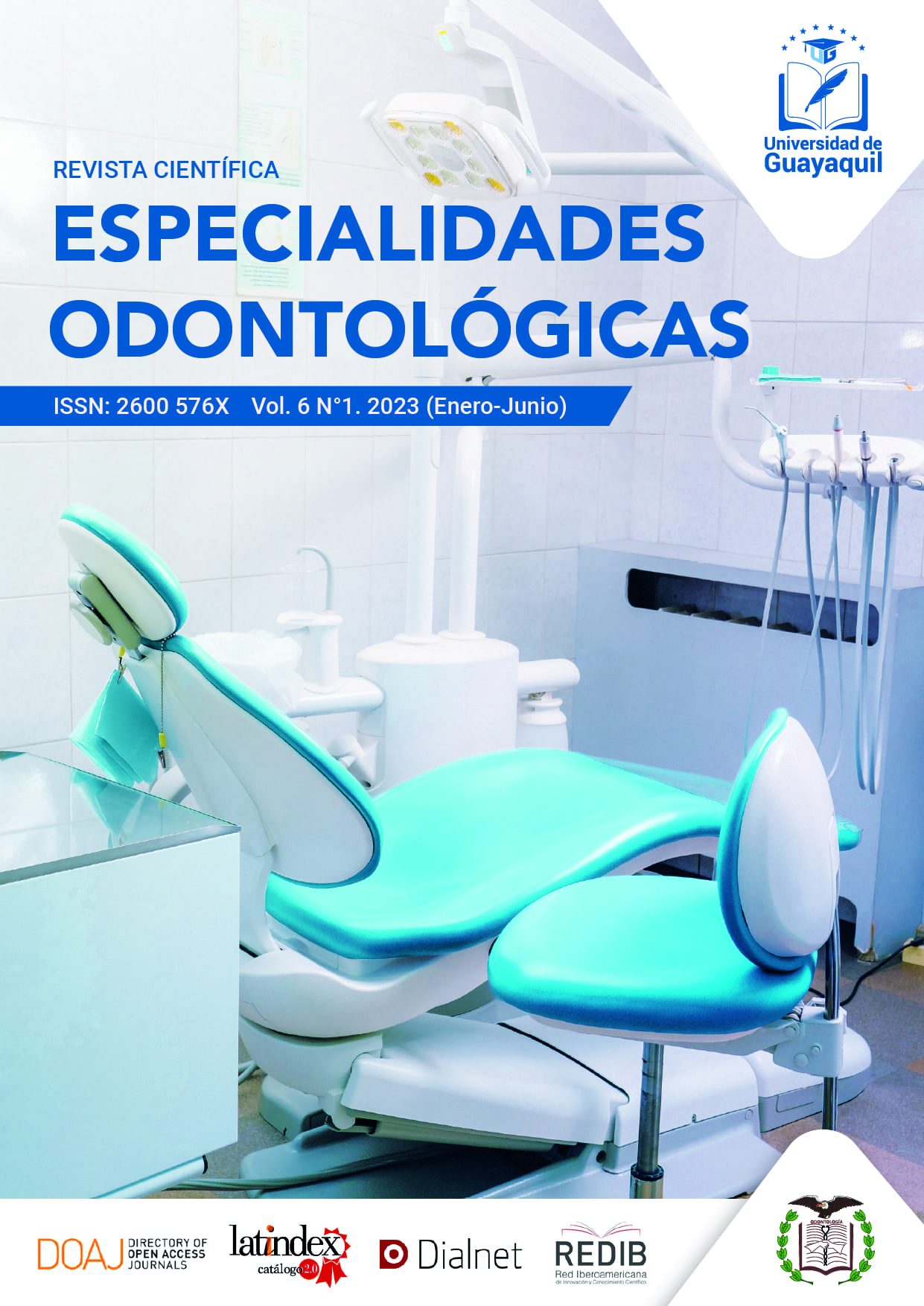Efecto antibacteriano del extracto de Ajo (Allium Sativum) y te verde (Camelia Sinensis) sobre Streptococcus Mutans Antibacterial effect of garlic (allium sativum) and green tea (camelia sinensis) extract on streptococcus mutans at 24 and 48 hours in buccal bacterial plaque
Contenido principal del artículo
Resumen
Objetivo: Determinar la efectividad inhibitoria del extracto de Ajo (Allium Sativum) y Te verde (Camelia Sinensis) sobre Streptococcus Mutans a las 24 y 48 Horas. Material y métodos: Estudio cuasiexperimental, prospectivo y longitudinal. La muestra estuvo constituida por cepas de Streptococcus Mutans aisladas de la placa dental de pacientes previo consentimiento e inoculadas en 20 placas Petri en Agar Sangre con 60 repeticiones para cada tratamiento y un control positivo y negativo por cada placa. Se obtuvieron los extractos de Ajo (Allium Sativum) y Te verde (Camelia Sinensis) por el método de maceración y evaporación. El control positivo fue la clorhexidina al 0,12% y el control negativo el agua destilada. El efecto inhibitorio fue medido por el método de Kirby Bauer y McFarlad. Se observaron los halos de inhibición a las 24 y 48 horas. El análisis de datos se realizó con las pruebas estadísticas de t y Tukey. Resultados: El mejor efecto inhibitorio lo registra el extracto de Ajo (Allium Sativum) al 100% a las 24 horas con un promedio de 15.67mm de halo inhibición frente al Té verde (Camelia Sinensis) al 100% que obtuvo un promedio de 14.18mm. Conclusiones: El extracto de ambas plantas tienen efecto inhibitorio in vitro frente a las cepas de Streptococcus Mutans. El extracto de Ajo (Allium Sativum) tiene mayor efecto inhibitorio en relación al Té verde (Camelia Sinensis) tanto a las 24 y 48 horas. El principio activo de ambos extractos se redujo a las 48 horas por lo tanto también efecto inhibitorio.
Descargas
Detalles del artículo

Esta obra está bajo una licencia internacional Creative Commons Atribución-NoComercial-SinDerivadas 4.0.
Citas
Zhang Y, Fang J, Yang J, Gao X, Dong L, Zheng X, et al. Streptococcus mutans-associated bacteria in dental plaque of severe early childhood caries. Journal of Oral Microbiology. 2022;14(1). Available from: http://dx.doi.org/10.1080/20002297.2022.2046309
Lemos JA, Palmer SR, Zeng L, Wen ZT, Kajfasz JK, Freires IA, et al. The Biology of Streptococcus mutans . Microbiology Spectrum. 2019 Feb 8;7(1).
Zhang Q, Ma Q, Wang Y, Wu H, Zou J. Molecular mechanisms of inhibiting glucosyltransferases for biofilm formation in Streptococcus mutans. Vol. 13, International Journal of Oral Science. Springer Nature; 2021. Available from: https://www.nature.com/articles/s41368-021-00137-1
Dinis M, Traynor W, Agnello M, Sim MS, He X, Shi W, et al. Tooth-Specific Streptococcus mutans Distribution and Associated Microbiome. Microorganisms [Internet]. 2022 May 31;10(6):1129. Available from: https://www.mdpi.com/2076-2607/10/6/1129
Hernandez AHM, Hernández MÁN, Chaloupková P, Fernández-Cusimamani E. Ethnobotanical study of the use of medicinal plants in the indigenous pijao community in natagaima, colombia. Boletin Latinoamericano y del Caribe de Plantas Medicinales y Aromaticas. 2021;20(5):482–95. Available from: https://doi.org/10.37360/blacpma.21.20.5.35
Nakayama HD, Samudio Oggero A, Talavera T, Armoa R. Medicinal and aromatic plants. The challenge of taking advantage of its by-products in the San Pedro department. 2021. Población y Desarrollo. 2022 Jun 30;28(54):16–23. Available from: https://doi.org/10.18004/pdfce/2076-054x/2022.028.54.016
Wallock-Richards D, Doherty CJ, Doherty L, Clarke DJ, Place M, Govan JRW, et al. Garlic revisited: Antimicrobial activity of allicin-containing garlic extracts against Burkholderia cepacia complex. PLoS ONE. 2014 Dec 1;9(12). Available from: https://doi.org/10.1371/journal.pone.0112726
Batiha GES, Beshbishy AM, Wasef LG, Elewa YHA, Al-Sagan AA, El-Hack MEA, et al. Chemical constituents and pharmacological activities of garlic (Allium sativum L.): A review. Vol. 12, Nutrients. MDPI AG; 2020. Available from: https://pubmed.ncbi.nlm.nih.gov/32213941/
Mazur M, Ndokaj A, Jedlinski M, Ardan R, Bietolini S, Ottolenghi L. Impact of Green Tea (Camellia Sinensis) on periodontitis and caries. Systematic review and meta-analysis. Vol. 57, Japanese Dental Science Review. Elsevier Ltd; 2021. p. 1–11. Available from: http://dx.doi.org/10.1016/j.jdsr.2020.11.003
Khurshid Z, Zafar MS, Zohaib S, Najeeb S, Naseem M. Green Tea (Camellia Sinensis): Chemistry and Oral Health. The Open Dentistry Journal. 2016 May 12;10(1):166–73. Available from: http://dx.doi.org/10.2174/1874210601610010166
Jimenez A, Zambrano M. Efecto antibacteriano del extracto de Allium sativum (ajo) blanco, púrpura y Clorhexidina al 0,12% sobre cepas de Streptococcus mutans. Available from: https://dialnet.unirioja.es/servlet/articulo?codigo=5802897
Montero-Recalde M, Vayas L, Avilés-Esquivel D, Pazmiño P, Erazo-Gutierrez V. Evaluation of two methods for measuring the sensitivity of growth inhibition of the certified Staphylococcus aureus subsp. Aureus Strain. Revista de Investigaciones Veterinarias del Peru. 2018;29(4):1543–7.
Ramos C, Gonzalo F. Efecto antibacteriano in vitro del extracto hidroalcohólico de Allium Sativum sobre el Streptococcus mutans estandarizado, Cusco 2016. Universidad Andina del Cusco; 2017.
Guillamon E. Efecto de compuestos fitoquímicos del género Allium sobre el sistema inmune y la respuesta inflamatoria. Ars Pharmaceutica (Internet). 2018 Sep 14;59(3). Available from: https://scielo.isciii.es/scielo.php?script=sci_arttext&pid=S2340-98942018000300185
Hernández E, Hernández A, Delia Tamayo D, Bruceta M. EL AJO EN EL TRATAMIENTO DE LA HIPERTENSIÓN ARTERIAL98-261-1-PB.
González B, Elizabeth J. Efecto de inhibición del extracto de té verde en concentraciones de 100%, 75%, 50%, 25% frente a streptococcus mutans en 20 muestras in vitro. Quito: UCE; 2018.
Anita P, Balan In, Ethiraj S, Madan Kumar P, Sivasamy S. In vitro antibacterial activity of Camellia sinensis extract against cariogenic microorganisms. Journal of Basic and Clinical Pharmacy. 2015;6(1):35. Available from: http://dx.doi.org/10.4103/0976-0105.145777
Cáceres Correa SA, Barba Guzmán CV, Carrero Castillo YN. Potencial medicinal de Camellia sinensis. Mediciencias UTA. 2020 Jul 6;4(3):14. Available from: https://revistas.uta.edu.ec/erevista/index.php/medi/article/view/1269
Juárez-Segovia KG, Díaz-Darcía EJ, Méndez-López MD, Pina-Canseco MS, Pérez-Santiago AD, Sánchez-Medina MA. EFECTO DE EXTRACTOS CRUDOS DE AJO (Allium sativum) SOBRE EL DESARROLLO in vitro DE Aspergillus parasiticus Y Aspergillus niger. Polibotánica. 2019 Jan 1;0(46). Available from: http://www.scielo.org.mx/scielo.php?script=sci_arttext&pid=S1405-27682019000100099




